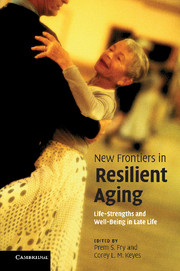Book contents
- Frontmatter
- Contents
- Figures
- Notes on contributors
- Foreword
- Acknowledgments
- Introduction
- 1 Sources of human life-strengths, resilience, and health
- 2 Growth is not just for the young: growth narratives, eudaimonic resilience, and the aging self
- 3 Physical resilience and aging:
- 4 You can teach an old dog new tricks:
- 5 Resilience in the face of cognitive aging:
- 6 Why do some people thrive while others succumb to disease and stagnation?
- 7 Psychosocial resources as predictors of resilience and healthy longevity of older widows
- 8 Resilience and longevity:
- 9 The socioemotional basis of resilience in later life
- 10 Emotional resilience and beyond:
- 11 Risk, resilience, and life-course fit:
- 12 Resilience in mobility in the context of chronic disease and aging:
- 13 Positive aging:
- Index
- References
2 - Growth is not just for the young: growth narratives, eudaimonic resilience, and the aging self
Published online by Cambridge University Press: 06 December 2010
- Frontmatter
- Contents
- Figures
- Notes on contributors
- Foreword
- Acknowledgments
- Introduction
- 1 Sources of human life-strengths, resilience, and health
- 2 Growth is not just for the young: growth narratives, eudaimonic resilience, and the aging self
- 3 Physical resilience and aging:
- 4 You can teach an old dog new tricks:
- 5 Resilience in the face of cognitive aging:
- 6 Why do some people thrive while others succumb to disease and stagnation?
- 7 Psychosocial resources as predictors of resilience and healthy longevity of older widows
- 8 Resilience and longevity:
- 9 The socioemotional basis of resilience in later life
- 10 Emotional resilience and beyond:
- 11 Risk, resilience, and life-course fit:
- 12 Resilience in mobility in the context of chronic disease and aging:
- 13 Positive aging:
- Index
- References
Summary
Abstract
In this chapter we present the case that growth is a central concern in older adults' self-identity, facilitating dispositional well-being and resilience in older adulthood. Contrary to the view that “growth is for the young and loss is for the old,” research on personal goals and memories demonstrates that older adults are at least as concerned with gain and growth as they are with loss. As for personal memories, we turn to quantitative research on narrative self-identity. Growth-oriented narratives are common in older adulthood. They predict well-being, differentiate hedonic from eudaimonic well-being, and differentiate two forms of eudaimonic well-being. Finally, we present a framework for studying resilience: hedonic resilience involves affect regulation in the wake of loss or potential trauma, whereas eudaimonic resilience includes affect regulation but additionally considers meaning regulation.
Introduction
Psychological resilience in old age, like in any period of adulthood, is intimately tied to self-identity. Some forms of self-identity are more likely than others to facilitate resilience across the lifespan (Greve and Staudinger,2006). For example, growth-oriented identities are more likely than others to precede increases in meaning-making and adaptation (e.g., Adler, 2009; Bauer and McAdams, in press; King and Smith, 2004; Pals, 2006b). In this chapter we argue that a growth orientation in one's self-identity serves as a central feature of the aging self and in doing so facilitates resilience. We make three claims about resilience and the aging self. First, growth is a normative, often central concern in older adults' personal goals.
- Type
- Chapter
- Information
- New Frontiers in Resilient AgingLife-Strengths and Well-Being in Late Life, pp. 60 - 89Publisher: Cambridge University PressPrint publication year: 2010
References
- 28
- Cited by



